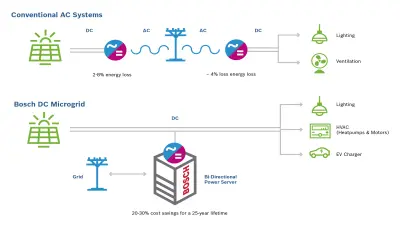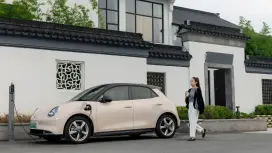Small grids with major benefits
Microgrids for a smart urban power supply

About two thirds of the world’s population will be living in cities by 2050 – this adds up to some six billion people. To make the power supply in urban areas sustainable, two changes are needed: energy consumption must be reduced and the use of renewable sources of energy promoted. Decentralized energy management systems, otherwise known as microgrids, are one way to achieve this.

The tiny giants of the power supply
Today’s cities already account for three quarters of the world’s total energy consumption, with existing buildings alone consuming 40 percent. While renewable sources of energy are gaining importance, meeting global energy demand with wind, hydro, and solar power alone is not currently possible. In 2017, a quarter of the power generated worldwide came from renewable sources. This shows that in the long term, energy consumption in cities will also have to be reduced. Microgrids can play a part in this. These energy management systems are relatively small, they can be run individually, and they provide large buildings with different sources of renewable energy. Microgrids are not only environmentally friendly, they are also reliable, as they are not connected to the main grid. Even when extreme weather or security issues cause a blackout, they continue to supply electricity for residential buildings and critical infrastructure. The Bosch DC Microgrid operates on direct current (DC) rather than alternating current (AC). As a result, it consumes up to ten percent less energy than a conventional AC based power distribution systems and significantly improves reliability in the facility.
Fit with the help of a microgrid
In 2017, Bosch completed a project in North Carolina, USA, which successfully reduced energy consumption at a local fitness center and emergency shelter and made its power supply more reliable. To achieve this, Bosch installed a DC energy management system. The microgrid provides electricity from a photovoltaic system on a DC power grid to the gym’s lighting and air conditioning. A lithium-ion energy storage system guarantees electricity in the event of a power blackout at night. As a result, the building is no longer reliant on a diesel generator. The new system increases the facility’s energy efficiency by 13 percent and reduces its power consumption by more than 55,000 kilowatt hours per year. This will save 105,000 euros in the next 25 years.
Three questions for…
1. Ms. Ravula, you are overseeing the commercialization of smart grids in the United States. What role can microgrids play in providing a sustainable power supply in the cities of the future?
Microgrids will enable facilities in the cities of future to become more efficient, intelligent, and resilient by using on-site power during power blackouts. They also meet renewable energy targets and reduce greenhouse gas emissions.
2. Where are microgrids especially useful?
DC microgrids can be used for large commercial and industrial facilities that see their business and operations threatened by unreliable utility grids and thus need a more intelligent and reliable power supply. In addition to large manufacturing facilities and distribution centers, these include large office buildings and retail buildings.
3. What potential do microgrids have for the next five years?
We expect microgrids to spread rapidly around the world. They can solve multiple challenges related to the power supply of the future, from aging AC grid infrastructure and global carbon emission reduction targets to higher efficiency and reliability requirements. According to expert forecasts, microgrids have the potential to become a multi-billion dollar business.

The revival of direct current
Which is more suitable for large scale power supply, DC or AC? The American inventors George Westinghouse and Thomas Edison fought over this question at the end of the 19th century. AC prevailed and is now the most common form of power. However, more than 100 years later, DC may be on the verge of a comeback. One reason is the high demand for consumer electronics, including computers, smartphones, and TVs, which run on DC transistors. Another reason is that DC is more efficient than AC for high-voltage transmission. It is no longer necessary to convert the power temporarily. This avoids energy-loss – thereby reducing operating costs and protecting the environment.
Conclusion
The International Energy Agency estimates that global demand for electricity will rise 30 percent by 2040. DC microgrids can help reduce urban power consumption, while at the same time making the power supply more reliable.
